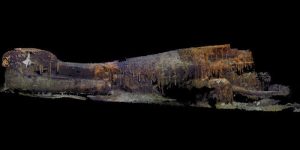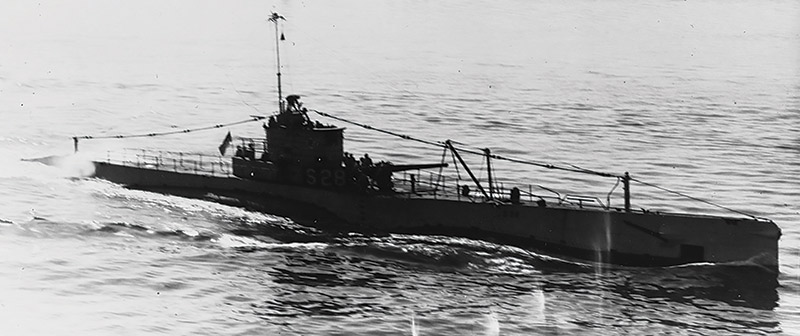Navy Validates Lost 52 Project Discovery of Identification of WWII Submarine S-28 Gravesite Off Oahu
July 4th is the 75th anniversary of USS S-28 loss.
After almost 75 years, utilizing advanced imaging technology, Ocean Explorer Tim Taylor and his “Lost 52 Expedition Team” officially discovered the final resting place for the 49 Sailors of the U.S. submarine S-28 (SS-133) off Oahu, Hawaii. The U.S. Navy recently validated the identity of the wreck, which Taylor located in 2017.
July 4th, 2019 marks the 75th anniversary of the loss of the submarine, which was conducting exercises at the time she disappeared.
“The discovery of the USS S-28 as part of my ‘Lost 52 Project’ continues to honor the men, their mission and their memory. It is important that they not be forgotten and that future generations recognize their invaluable sacrifice for our country and the world,” said Taylor.
“Identification of a Navy gravesite is something Naval History and Heritage Command’s Underwater Archaeology Branch takes great care in doing,” said Sam Cox, Director of Naval History and Heritage Command. “After an exhaustive review of the data provided by Tim Taylor’s team, we can positively identify the wreck as S-28.”
The keel of USS S-28 (SS-133) was laid down in April of 1919, just months after the end of the First World War. Commissioned on December 13, 1923, the S-Class submarine spent 16 years taking part in various Navy exercises in the Caribbean and eventually the Pacific.

When Pearl Harbor was attacked on December 7th she was being overhauled at Mare Island Naval Shipyard outside of San Francisco, California. She was one of several S-boats put into service in World War II and was initially sent to Alaska to defend the Aleutians against a possible Japanese invasion. By mid-November, S-28 arrived in Pearl Harbor and for the next seven months trained in the waters around the island.
On July 3, 1944, S-28 embarked on an antisubmarine warfare training exercise off the coast of Oahu, Hawaii. During the training, communication became sporadic and the boat sent her last communication to the Coast Guard cutter Reliance the evening of July 4th. Navy’s search of the area did not reveal the location of the submarine and two days later, a diesel oil slick appeared in the area. Later, a Navy Court of Inquiry could not determine the cause of the loss. During her service during WWII, she completed six war patrols and earned one battle star.
 “We’re thankful for the care and attention Tim and his team took in locating the wreck. Because of their efforts, we now know the final resting place of our shipmates. This discovery helps to ensure their service will always be remembered, honored and valued and we hope provides some measure of closure to their families,” continued Cox.
“We’re thankful for the care and attention Tim and his team took in locating the wreck. Because of their efforts, we now know the final resting place of our shipmates. This discovery helps to ensure their service will always be remembered, honored and valued and we hope provides some measure of closure to their families,” continued Cox.
S-28 (SS-133) rests in approximately 8,700 feet of water, which made the location of the ship impossible due to technological limitations of the era.
After such an initial discovery, archeologists conduct exhaustive research to ensure its identity. In the case of S-28 the location at which it was discovered offered a key clue to its identity.
 Following World War II, the U.S. tested ordnance and scuttled U.S. and Japanese ships in the vicinity of the wreck site. Records indicated that her sister ship, USS S-35, had been scuttled in that same area. Finding the subtle differences between the two series of S-class submarines demanded some technical expertise and analysis. Through Taylor’s research, paired with historical archives, the Naval History and Heritage team were able to positively identify the wreck comparing design differences. Records revealed the hulls had uniquely different cowling covers on the forward bow planes.
Following World War II, the U.S. tested ordnance and scuttled U.S. and Japanese ships in the vicinity of the wreck site. Records indicated that her sister ship, USS S-35, had been scuttled in that same area. Finding the subtle differences between the two series of S-class submarines demanded some technical expertise and analysis. Through Taylor’s research, paired with historical archives, the Naval History and Heritage team were able to positively identify the wreck comparing design differences. Records revealed the hulls had uniquely different cowling covers on the forward bow planes.
The investigators also considered some likely superstructure modifications and the probability that deck guns were removed from the S-35 before it was scuttled as possible indicators. Ultimately, however, the cowlings provided the evidence the team needed to make the final confirmation.
“The differences in external configurations are minimal on these 100-year-old submarines, but the cowlings are a distinct indicator,” states Taylor.
Taylor’s team utilized advanced photogrammetry to create imaging that allows them to research the site long after they have returned to the dock. The data produced by their expedition was key in helping to confirm that we were looking at the S-28 and not the S-35.
The Lost 52 Expedition 2017 deploys state of the art deep-water autonomous underwater vehicles (AUV’s) as well as remotely operated vehicles (ROV’s). Mr. Taylor, CEO of Tiburon Subsea Services, Inc., and director of non-profit Ocean Outreach, Inc. has a reputation for working with the latest in undersea technology and with the top specialists in underwater exploration. This is Mr. Taylor’s fourth US WWII submarine discovery since 2010 and is part of his ongoing “Lost 52 Project”. The ongoing multi-year project is supported by STEP Ventures, who are dedicated to continuing work of the “Lost 52 Project” and shares its commitment to preserving and honoring the legacy of the lost WWII submariners and the bravery of our sailors for future generations.
Tim Taylor is a renowned ocean explorer, expedition leader, and underwater robotics expert who has spent twenty-nine years exploring the oceans. He has collaborated with noted geologists, marine biologists, archeologists, coral and shark scientists. In 2008 Tim received the Explorers Club “Citation of Merit” for his contributions to exploration. Over the past decade, his focus has been on the utilization of robotic technology in underwater expeditions. He pioneered a 1500-meter deep AUV search for submerged cultural resources spanning three years and 1800 square miles. His recent discoveries include three US WWII Submarines.
Tim has been profiled in the London Financial Times, The New York Times, Bloomberg News and is a regular contributor on FOX, CNBC, BBC, CBC and CNN as an ocean technology and robotics expert. He is President of Tiburon Subsea Services specializing in supplying autonomous underwater robotics and founder of Ocean Outreach home of the “Lost 52 Project” dedicated to educating the next generation of ocean advocates.

